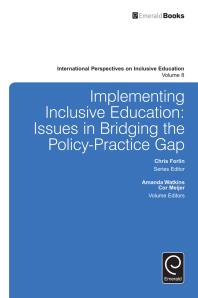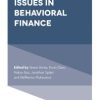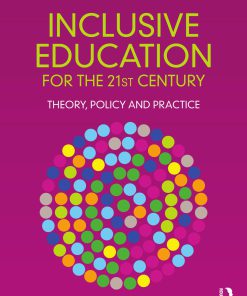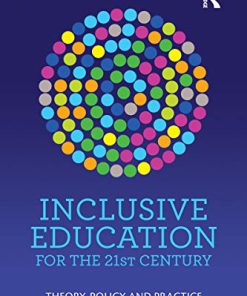Implementing Inclusive Education Issues in Bridging the Policy Practice Gap 1st Edition by Amanda Watkins, Cor JW Meijer, Chris Forlin ISBN 9781786353870 1786353873
$50.00 Original price was: $50.00.$25.00Current price is: $25.00.
Implementing Inclusive Education Issues in Bridging the Policy Practice Gap 1st Edition by Amanda Watkins, Cor JW Meijer, Chris Forlin – Ebook PDF Instant Download/Delivery: 9781786353870 ,1786353873
Full download Implementing Inclusive Education Issues in Bridging the Policy Practice Gap 1st Edition after payment

Product details:
ISBN 10: 1786353873
ISBN 13: 9781786353870
Author: Amanda Watkins, Cor JW Meijer, Chris Forlin
Implementing Inclusive Education Issues in Bridging the Policy Practice Gap 1st Edition Table of contents:
Section I: Key Policy Areas for Inclusive Education
Ensuring a Strong Start for All Children: Inclusive Early Childhood Education and Care
Introduction
Definition and EU Approach to ECEC
Quality in ECEC
Main Policy Issues and Recommendations for Quality Inclusive ECEC
Inclusive Access to ECEC
The ECEC Workforce
Curriculum
Monitoring and Evaluation
Governance and Funding
Importance of an Inclusive Framework
Issues to Be Raised on Quality of ECEC
Concluding Comments
References
Financing Inclusive Education: Policy Challenges, Issues and Trends
Introduction to Key Policy Issues for Financing Inclusive Education
Incentivise Inclusive Education to Promote the Right to Education for All
Shifting Resource Allocation Mechanisms Away from a Needs or Disability Type of Approach
The Need to Convince Stakeholders to See Diversity as an Opportunity
Promote Equity in Education through Decentralised, Flexible and Accessible Learning Environments
Incentivising Cross-Sectoral Policies and Practices for Accessible Learning Environments
Encouraging Flexible Support and Teaching
Embed Learners’ Rights in Effective Governance and Accountability Mechanisms
Fostering Synergies among Stakeholders through Effective Governance Mechanisms
Effective Monitoring and Accountability Mechanisms for Appropriate Quality Assurance Frameworks
Conclusions
Shift from Ineffective, Inequitable and Labelling Resource Allocation Mechanisms …
… To Decentralised and Flexible Inclusive Education Systems Focusing on the Enabling Effect of Pol
…And Embedding Learners’ Rights in Effective Governance and Accountability Mechanisms
Acknowledgement
References
Educating All Teachers for Inclusion
Introduction
Teacher Education Across Europe – The Current Policy Context
The Need for Policy Initiatives Promoting Values Based Approaches to Inclusive Education
The Need for Policy that Promotes Inclusion as a System-Wide Issue
The Need for Policy that Promotes Teacher Education for Inclusion
Barriers to Implementing Policy for Teacher Education for Inclusion
Different Approaches to Competence Development
The Need for a Deeper Understanding of Inclusion
The Need for ‘Mature’ Sites to Develop Inclusive Practice in Collaboration with Experienced Teac
The Role of Specialised Courses
The Role of Teacher Educators
Supporting the Implementation of Policy on Teacher Education for Inclusion
Organisation of Courses that Prepare All Teachers for Inclusion
Schools Practice Opportunities
Links between ITE and CPD
Moving Policy for Teacher Education Forward
National Policies for Inclusive Education
Curriculum Development
Concluding Comments
References
Inclusive Vocational Education and Training (VET) – Policy and Practice
Introduction
Changing Labour Markets
Learners with Disabilities and/or SEN in VET
The Role of Career Guidance
VET as a Pathway to Employment for Learners with Disabilities and/or SEN
Quality Improvement/National Qualifications Frameworks (NQF)
Key Aspects of Successful VET Policy and Practice
VET Institution Management
Implementing Learner-Centred Approaches for Developing Skills Relevant to the Labour Market
Focusing on Learners’ Capabilities for Developing Work Opportunities that Better Match Learners’
Conclusion
Note
References
Section II: Support and Provision
How Can Education Systems Support All Learners? Tipping-Point Leadership Focused on Cultural Change
Introduction: Global Challenges in the European Context
Theoretical Approach on Policy Issues and Challenges Relating to Inclusion
Institutionalisation of Inclusive School Cultures
The Flensburg Beacon: Creating Conditions for Change
Policy Statements and Challenges in Practice
Preconditions for Inclusion in Flensburg’s Context
The Waldschule: Transformation in an Extraordinary Situation
The Development and Institutionalisation of a More Inclusive Culture
Overcoming Barriers: Four Fundamental Conditions for Inclusive Development
The Essunga Beacon: Underlying Forces in Developing Increased Capability
Policy Statements and Challenges in Practice
Preconditions for Inclusion in Essunga’s Context
Nossebro School: Transformation in an Extraordinary Situation
The Development and Institutionalisation of a More Inclusive Culture
Overcoming Barriers: Underlying Mechanisms of Increased Inclusive Capability
Conclusion
Fundamental Policy and Education System Factors for Change
Mechanisms for Local School Transformation
Underlying Understanding and Trust in a Learning Chain of Command
Notes
References
Multicultural Diversity and Special Educational Needs
Introduction
Definition
EU Approach to Diversity
Educational Measures
SEN and Ethnicity: Key Issues to Consider
SEN and Ethnicity: Over and Under-Representation
A Study of SEN and Ethnic Disproportionality’
What Was the Focus?
What Did We Do?
What Did We Find?
Exploring the Perspectives of Children and Young People with SEN
Career Choices of Young Disabled People
Methods
Multiculturalism
Findings
Multicultural Diversity, SEN and Inclusion
Effectiveness and Values
Conclusions
Main Policy Issues
How Do we Action These Issues?
What Are the Difficulties in Implementing These Recommendations?
Overcoming the Difficulties
Finally
References
ICT as a Tool for Supporting Inclusive Learning Opportunities
Introduction
European Level Policy Directives and Guidance
Legislation and Policy Promoting Equity in Educational Opportunities
Access to Appropriate ICTs for Learners with Disabilities and/or SEN
Identifying the Policy-Practice Gaps
Introducing Kim
The Availability of Technology to Support Access to Inclusive Learning Opportunities
A Policy Framework that Ensures Equitable Access to Learning Opportunities
Empowering All Learners through the Use of ICTs that Meet Their Wider Learning Needs
Acknowledgement
References
Addressing the Challenges of Raising Achievement for All
Introduction
Policy Issues
Policy Priorities
Meeting the Challenge of Raising Achievement for All Learners
Raising Achievement through Leadership and Learning
Leading Learning through Inclusive School Self-Evaluation
Leadership Development
Change Wisdom
Stages of Concern
Trust
Instructional Leadership Programme
Collaborative School Practice as a Response to Diversity
A Culture of Acceptance and Valuing
Learner Voice – Personalisation
Pedagogy for All
Concluding Remarks
Notes
References
Section III: Monitoring the Implementation of Inclusive Education
Inclusive Assessment: Issues and Challenges for Policy and Practice
Introduction
High Quality Inclusive Assessment
At National Level
At Local/School Level
Policy and Practice Issues – Addressing the Challenges
The Need to Provide Clarity about the Purposes of Assessment
Raising Awareness of Education Decision Makers
Designing Assessment Procedures which Are Coherent and Fit for Purpose
Assessment for Identification of Needs without Labelling/Categorising Learners
High Stakes Assessment and Accountability Issues
Investment in Teacher Education
Concluding Remarks
References
Efficiency, Effectiveness and Equity within Inclusive Education Systems
Introduction
Why Is System Monitoring in Relation to Efficiency, Effectiveness and Equity a Policy Priority?
Challenges in Implementing Effective Monitoring of Inclusive Education Systems
Definition Issues
Inclusive Policy and Practice Issues
What Should be Monitored in Relation to Efficiency, Effectiveness and Equity?
Data on System Inputs
Data on System Processes
Data on System Outcomes
System Monitoring
Monitoring Efficiency, Effectiveness and Equity as a Policy Development Imperative
Monitoring Learners’ Rights as an Equity Issue
Monitoring System Effectiveness
Concluding Comments
References
Young Voices on Inclusive Education
Introduction
Five Key Messages for Inclusive Education
Key Message One ‘as Early as Possible’
Key Message Two ‘Inclusive Education Benefits All’
Key Message Three ‘Highly Qualified Professionals’
Key Message Four ‘Support Systems and Funding Mechanisms’
Key Message Five ‘Reliable Data’
Young Voices in Relation to Key Messages from the European Agency Work
As Early as Possible
Inclusive Education Benefits All
Highly Qualified Professionals
Support Systems and Funding Mechanisms
Inclusive Education – Take Action! The Luxembourg Recommendations
Priority 1 – Everything about Us, with Us
Priority 2 – Barrier-Free Schools
Priority 3 – Breaking Down Stereotypes
Priority 4 – Diversity Is the Mix, Inclusion Is What Makes the Mix Work
Priority 5 – Becoming Full Citizens
Concluding Comments
References
Summary and Conclusions: Ways Forward in Bridging Policy-Practice Gap Issues within Inclusive Educat
Raise the Achievements of all Learners
Ensure that all Stakeholders Value Diversity
Ensure the Availability of Flexible Continua of Provision and Resources
Raise the Achievements, Outcomes and Outputs of the Overall System
Inclusive Education Systems as Learning Systems
Concluding Comments
About the Authors
Index
People also search for Implementing Inclusive Education Issues in Bridging the Policy Practice Gap 1st Edition:
challenges in implementing inclusive education pdf
challenges in implementing inclusive education
challenges faced by botswana in implementing inclusive education
issues and challenges of implementing inclusive education
strategies for implementing inclusive education
Tags: Amanda Watkins, Cor JW Meijer, Chris Forlin, Implementing Inclusive Education, Policy Practice Gap
You may also like…
Mathematics
Big data in education the digital future of learning policy and practice Ben Williamson.
Uncategorized
Education Policy research epistemological and theoretical issues 1st Edition Mainardes
Education Studies & Teaching - Educational Theory
Inclusive Education for the 21st Century: Theory, Policy and Practice 2nd Edition Linda J. Graham
Uncategorized
Education Policy Research Epistemological and Theoretical Issues 1st Edition Mainardes
Jurisprudence & Law
Open Source Law, Policy and Practice 2nd Edition Amanda Brock
Education Studies & Teaching - School Education & Teaching
Education Studies & Teaching - Educational Theory











